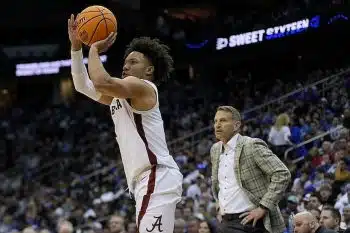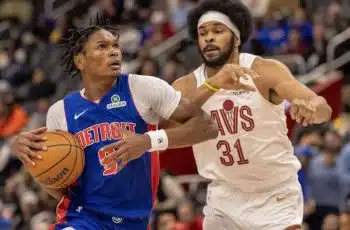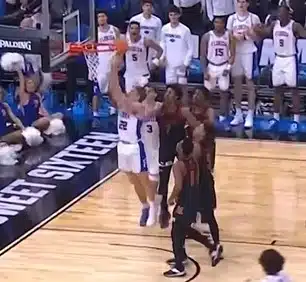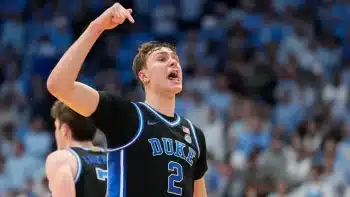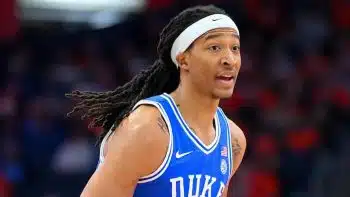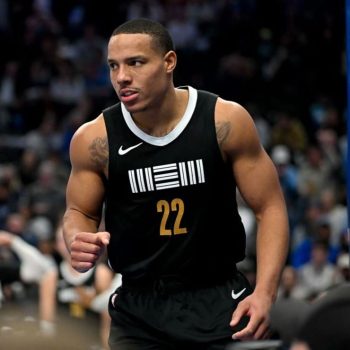NCAA
Nike Hoop Summit Team USA Report
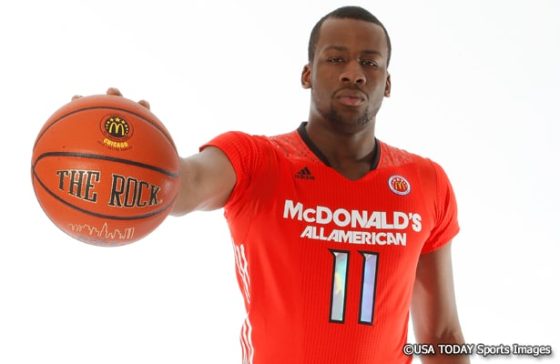
The United States Junior Select team took a two-game losing streak against the World Select Team into Saturday’s Nike Hoop Summit, a game that annually pits the best of the American senior high school class against the some of the best players 19-and-under from the rest of the world. It is the premier scouting event of the high school All-Star circuit because the coaches and players actually try to win. The World team began practicing in Portland on Monday, while a smarting USA basketball* brought in its players a day earlier than normal, beginning practices Wednesday before staging two-a-days Thursday and Friday.
*In the postgame press conference, USA coach Mike Jones of DeMatha High School in Maryland alluded to the fact that he wasn’t sure he’d be brought back after the last two losses.
This US team was notable for its vocal, positive attitude in the practices, and they played like it in the game. Team USA fell behind early as they initially struggled to solve World coach Roy Rana’s extended 3-2 zone, which he deployed from the jump on makes and dead balls. The US trailed 24-15 at one point after some temporarily hot shooting by the World team, but roared back to take the lead by halftime with the help of foul trouble for the World’s three best big men. Ultimately, Team USA’s withering press and overall athleticism forced the World into 21 turnovers and held them to an offensive rating of 82.9 over 88 possessions in an 84-73 win. USA basketball did well to assemble a team and coaching staff that brought home a win against a World team that probably would have been favored by most of the NBA personnel in attendance.*
*Those scouts were only allowed to view one USA practice, a Thursday scrimmage against local collegians and low-level pros in which the US made two jumpers outside the paint the entire night.
Although much of the World was comprised of US high schoolers, they lacked any athletic wings the quality of Americans Justise Winslow, Stanley Johnson, Kelly Oubre and Theo Pinson. Much like at the senior national level, where international teams have no answer for the American wings, they proved the difference in this game as well. Here is how the individual American prospects break down.
Potential Stars
Jahlil Okafor, Center, Committed to Duke
Okafor is by far the best known player in this class. By now, most are aware of his strengths and weaknesses. He has fantastic post moves and touch with either hand. The Chicago native is quite light on his feet for someone his size–6’11, 272. His wingspan and standing reach easily check the boxes for a center.
His weakness is exactly what you would expect for a heftier big guy with limited explosion: rim protection. However, his quick feet make him a reasonable pick-and-roll defender, and he was able to switch onto guards on occasion without getting absolutely torched.
Okafor could stand to get into better cardio shape, like most high school big men. When he is fresh though he can get out in transition and is a capable finisher due to his great hands and footwork. While he has become more explosive, he is not going to go up and dunk on anyone, and needs to continue to work on using his body to create space. With his frame, he could also work much harder on Zach Randolph-style duck-ins. If Okafor gets into good enough shape to outwork guys in addition to outskilling them, he could be an absolute terror. At times he over-relies on his balletic post moves when he needs to just put his shoulder into guys, back down and shoot a jump hook. Instead, he likes to catch the ball pretty far out and work his way into the lane with spin moves, but these proved easy to strip from guards digging down. Dealing with double teams is also an enormous weakness of his, as he will simply retreat into the corner when this occurs and rarely makes an incisive pass from the post. All of that should improve in time, and he will likely have plenty of space to operate regardless in Duke’s open system.
Okafor has a long windup on his jumpshot, but it goes in pretty well for him from midrange. This will likely be an effective weapon for him in time. I am less sanguine on his prospects as a pick-and-roll finisher due to his lack of explosion, but his great hands and footwork should enable him to be moderately effective rolling to the basket a la Marc Gasol as long as there are not great shot-blockers in his way.
It seems likely that Okafor will be a top five pick next year, but his limited rim protection somewhat limits his ceiling. At this point, I would compare his game, if not his temperament, to a less physical version of DeMarcus Cousins.
Cliff Alexander, Power Forward, Committed to Kansas
Unlike the rest of these players, this was Alexander’s first USA basketball event. Alexander’s best attribute right now is his ability to power up strong with two-foot dunks around the rim. If he gets the ball on a dump off, it’s a bucket or a foul every time. Because he is such an explosive finisher on film, it was surprising to see how short he was in person. He is 6’8 in shoes, although with a 9’0 standing reach and 7’3.5 wingspan. He can also be an impressive shot blocker, although it takes him quite a while to load up and jump so he barely misses a lot of shots in the air. He also has a fledgling jump hook shot, although no real counters at this point.
If he were center-sized with his explosiveness, he would probably be the favorite for the number one pick in 2015. As it is, he will need to develop more of an outside game to become an elite NBA prospect. This may be in the offing, as he shoots his jumper easily with solid form and shoots free throws acceptably for a high school big man. Aside from working on his outside game, Alexander needs to get in better shape from both a cardiovascular and physical standpoint. At 251 pounds, he could stand to lose about 10 pounds and really cut up. It would also help him to slide his feet on defense and jump more quickly.
Alexander’s other main weakness right now is his basketball IQ. He only started playing the game a few years ago, and has absolutely no idea how to deal with double teams.* At times in practice his attention seemed to wander, and although he was not awful mentally he was the most likely on the team to mess up a drill or a play.
*He was not helped by the fact that the US team did not practice this at all, despite the fact most of their plays were designed to elicit postups for Alexander and Okafor.
If Alexander can increase his skill level and slim down a bit, he could be a top five pick next year. His upside might be something like Amar’e Stoudemire if he really improves, but there is also the possibility he never develops and remains a raw dunker.
Potential NBA Rotation Players
Stanley Johnson, Wing, Committed to Arizona
Johnson earned his frequent Ron Artest comparisons this week, weighing in at a giant 237 pounds on his 6’7 frame. In fact, I cannot think of a prospect in recent history who has a more apt NBA comparison. He is going to be a terror on defense with his 6’11 wingspan, as he gets copious steals on his man or off ball through anticipation. One on one, he moves his feet much faster than someone his weight should be able to. He really gets into his man and takes pride in his defense. Johnson was particularly impressive in Friday night’s scrimmage, when the US overwhelmed local collegians with their press and he had at least five steals. He is a bit handsy out on the perimeter, but that should be easy for Sean Miller to clean up next year. In the game itself, Johnson actually guarded World team point guard Emmanuel Mudiay most of the time. But he then was able to switch to playing as a four and blow by the bigs at the base of the World’s 3-2 zone. That lineup was key to the US comeback in the second quarter.
On offense, the Mater Dei high school product is a good one foot jumper, although he is less explosive off two. He did not appear to possess a ton of advanced dribble moves, but the spacing was rarely there for such attempts. His jumper is improving, and he was able to hit about 50 percent of FIBA threes in warmups when he was shooting set shots directly off the catch. Unfortunately, his release is very low in front of his head and he is much less effective shooting actual jump shots off the dribble.
Johnson is not going to be an offensive superstar, but much like Artest he should be able to manufacture points using his strength and an adequate jumper in time. His defense alone should ensure a long career.
Kelly Oubre, Wing, Committed to Kansas
The 6’6, 204 pound lefty might have the best physical profile of anyone on the USA team with his 7’2 wingspan and nuclear powered right calf, as evidenced by his dunk on former Oregon Duck Mike Moser during a scrimmage.

Oubre can also heat up from outside on occasion, hitting two key FIBA threes (the line is a little over two feet beyond the high school line) to spark the US comeback, though he finished 2-7 overall. His jumper waxed and waned, and he looks like he’ll be more of a streak shooter than a knockdown spotup guy for the time being.
The Houston area native played his part getting steals in the US pressure defense, although he doesn’t D up quite like Winslow or Johnson. For weaknesses, he did not seem to have a lot of advanced dribble moves (though it could be difficult to tell due to the lack of spacing for the US in the halfcourt) and did not shoot a shot with his right hand all week.
With his physical profile and ability to get to the basket and at least shoot passably, Oubre has the makings of a lottery pick. If he can improve his intensity and become a lockdown defender under Bill Self, he can cement that status. Among the four US wings, he has the most upside.
Myles Turner, Center, Undecided
Turner was not at his best this week due to a knee injury. He ran with an awkward limp and pretty much was unable to sprint all week, finally succumbing to a sprained ankle in the game after only seven minutes. Scouts were very concerned about his body, but he was not nearly as awkward when I saw him last year at adidas Nations so it could simply be the result of the injury. He has grown an inch and added 1.5 inches to his standing reach since October, while putting on 12 pounds to get up to 242. He has enormous feet, leading one to think he might grow even more.
At his best, the now 6’11.5 Turner is effective challenging shots with his 7’4 wingspan and 9’1.5 standing reach, but he was not really able to make his presence felt to his usual extent, this week. He also possesses a solid jump shot out to the FIBA three point line, although he had few chances to display this in Team USA’s post-centric offense. The Texas native has little feel on the block, and does not look like he’ll be comfortable putting the ball on the floor facing up or off closeouts either. Still, a player who can block shots and shoot threes is quite valuable, and Turner could be that assuming his health issues subside. For this week, he gets an incomplete.
Justise Winslow, Wing, Committed to Duke
The Houston native has an NBA body right now at 6’6, 221 lbs, and really has since he was a rising junior in high school. The lefty also has NBA athleticism, showing an ability to sky behind the defense for alley oops off one or two feet, pressure the ball and get out for dunks in transition. He also exhibited a quick first step in the half court going to his left, although he struggled to finish over challenges at the rim when he couldn’t dunk the ball.
In the actual game, Winslow overwhelmed the World team at times with his athleticism and intensity, much as he did for Team USA at the U-19 World Championships in Prague last summer. Against higher quality athletes at adidas Nations last summer and in the practices here, he was not able to exert his will on the glass and in transition quite as easily. In those settings, his deficiencies are more apparent. His jumper is a work in progress, and while he is clearly working on going right and finishing right handed neither is an effective weapon for him yet. He can dribble the ball upcourt, but largely dribbles defensively because he is not confident enough in his handle when smaller guards are around in transition. He is also very handsy on defense when defending on the perimeter, a tactic he should soon be disabused of at Duke with the new college emphasis preventing contact on the perimeter.
At a minimum, Winslow’s physical profile, good character and motor should give him an NBA future. Whether he can become more than just a back of rotation defensive wing depends on how much he can improve his shooting, non-dunk finishing and moves off the dribble.
Theo Pinson, Wing, Committed to North Carolina
As the thinnest of the US wings, the 6’6 Pinson was not the physical force of nature that the rest of the US wings were, but he probably has the best game off the dribble. He is a good but not great athlete who can slither to the basket and is effective in transition. He also has a nascent in between game for shots in the lane where he can’t get all the way to the rim. Pinson got going from outside in Friday night’s scrimmage, but aside from that his flat jumper was not falling and did not really appear to be a great weapon at this point, at least from the FIBA line.
His biggest project right now is to get stronger. He has only gained six pounds in the last two years, and weighed in at only 188 at the Hoop Summit. Strength will help his finishing at the rim and ability to get there to begin with when he hasn’t completely beat his man. On defense he too has a huge wingspan of 6’11, but was not a stopper on the level of Johnson or Winslow. Adding strength will help there as well. Right now, he is reminiscent of a worse-shooting Tony Snell. To become an NBA rotation player in the future he will have to get much stronger or become a much better shooter.
Of note, Pinson managed to tough out an ankle injury sustained in Thursday’s scrimmage to make it through two practices Friday and the game on Saturday.
Tyus Jones, Point Guard, Committed to Duke
Jones is going to be a very steady college point guard. He runs the team, knows when to make incisive passes or simply the right one and generally avoids turnovers. His in between game is wonderful, as his floaters from the dreaded 3-9 foot range were money all week no matter what angle he was penetrating from. Down the stretch, he abused the World team’s Jamal Murray for a couple of buckets to ice it for Team USA.
Unfortunately, he lacks a standout offensive skill aside from his passing. He lacked the ability to finish at the rim even at this level, which has resulted in his developing the aforementioned floater. At 6’1 with a 6’3 wingspan and only 7’10 standing reach, he does not have impressive size for a pro point guard. He also is not really a leaper–he doesn’t dunk even on fast breaks–and his quickness is perhaps slightly below average by NBA standards. He exhibits solid form on his jumper, but was not willing to shoot when the defense went under the pick and roll. He took a few wide open threes but largely missed them. I suspect he will improve his shooting in time though, as his jumper is not broken by any means.
Jones is a high character player who doesn’t make mistakes. That could eventually get him a role in the league as a backup point guard. But he’s unlikely to be a starting level player unless he can improve his jumper to nearly automatic.
Good College Players
Reid Travis, Power Forward, Committed to Stanford
Despite being listed at only 6’7, the Hoop Summit roster listed Travis as a center. This proved accurate, as he doesn’t really have the quickness to play away from the basket. While he readily takes 17 footers, his jumper is pretty hitchy and does not project to be a major weapon without some refinement. Travis is a sculpted 6’8, 241, with commensurate 7’0 wingspan and 8’8.5 standing reach that is adequate but not spectacular. His game evokes Carlos Boozer’s in college, before he evolved into a solid midrange shooter. However, he is not quite as strong as Boozer, nor does he jump as high at this point. He does show more defensive effort though, and moves his feet well for his size.
Travis’ best attribute right now is how hard he plays, which manifests on the offensive glass and racing the floor in transition. He crashes the glass hard for tip-ins, although he can’t quite get up for follow dunks. The key for Travis’ NBA future will be developing a midrange jumper (ironing out the kinks in his form) and increasing his explosiveness. Right now to these eyes he projects as the type of player who will stay in college and could eventually be a second round pick, but lacks much more upside than that.
Joel Berry, Point Guard, Committed to North Carolina
Joel Berry struggled more this week than anyone on either team. He goes 6’2, 185 with a 6’3 wingspan, and appears to be an average NCAA athlete for the point guard position. He has solid form on his jumper, but didn’t appear comfortable shooting even at the college three point line. The North Carolina commit struggled with turnovers throughout the week, with entry passes to the US post players proving a particular foible. Other than odd man fast breaks, he wasn’t really able to get to the basket either.
Berry didn’t hurt the US in the actual game, but Tyus Jones played 32 of the 40 point guard minutes for a reason. Throw in the fact he just turned 19 on April 1, and it is hard to see Berry as much of a prospect at this point. Frankly, it was surprising that Berry was considered the second-best point guard in this class by USA Basketball.
James Blackmon, Jr., Shooting Guard, Committed to Indiana
The 6’3 Blackmon has one outstanding skill: His jumper was money all week when left open out to the international three point line. With a 6’8.5 wingspan, he should be able to hold down the shooting guard position just fine at Indiana. However, he probably is not athletic enough to really qualify as an NBA prospect either, especially since he turns 19 in a few days himself. The only way that might change is if he can develop some point guard skills and become a lockdown defender a la the similarly sized George Hill, but Blackmon did not display that type of mentality or quite that level of athleticism this week. Although not a top-level prospect, Blackmon was a good choice for a Hoop Summit team that needed shooting.
Programming Note:
We previously ran a preliminary report after last Thursday’s practices, and will have a full report on the World team, including Karl Towns, Emmanuel Mudiay and Sviatoslav Mykhailiuk in the next few days.
